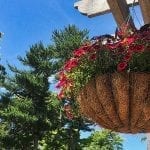
Top 10 Indoor Hanging Plants + Plant Care Tips
Hanging plants in handmade macramé holders was all the rage in the ’60s. Today, indoor hanging plants are often used to bring a touch of greenery to boho and eclectic interiors.
If you’re thinking about adding indoor hanging plants to your décor, read on for indoor plant tips and how-tos.
What indoor plants grow well in hanging planters?

Air Plant (Tillandsia)
Air plants are the perfect low-maintenance plant because they thrive without soil. Choose a hanging planter with a wide opening so the plant receives plenty of air circulation.
A clear plastic or glass terrarium works well. Air plants prefer lots of bright, filtered light, so it is best to hang them in a sunny window. If your indoor air is dry, submerge the plant in water for an hour or two, approximately twice a month.
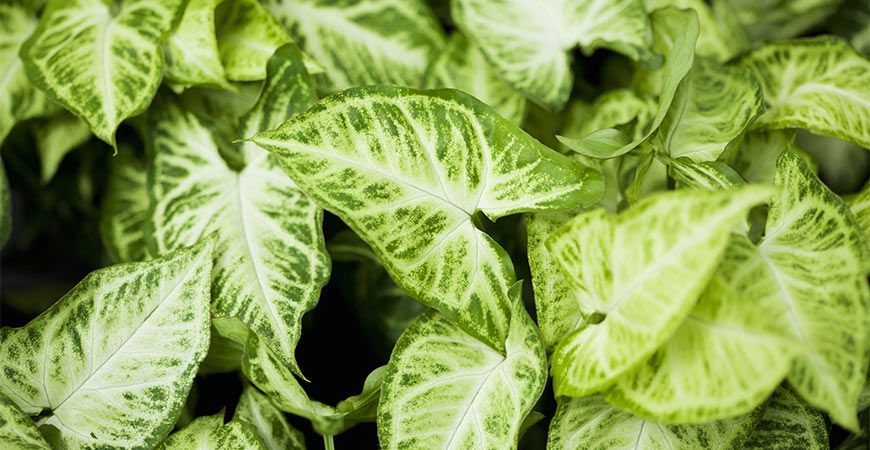
Arrowhead Plant (Syngonium Podophyllum)
Arrowhead plants and often referred to as five fingers because the long, arrowhead-shaped leaves grow “fingers” as they mature. They start as a compact plant to grow into a long, trailing vine.
Available in colors of burgundy, pink, and green, the arrowhead plant prefers a warm, humid location such as a bathroom or kitchen. Mist the plant occasionally to add humidity.
Arrowhead plants prefer rich potting soil and bright indirect light. Fertilize the plant with liquid plant food in spring and summer.

Bird’s Nest Fern (Asplenium nidus)
Bird’s nest fern is a type of epiphyte, a plant that grows on another plant. Grow the plant on a piece of wood or rock placed in a hanging planter. The leaf shape will vary according to the plant’s sunlight.
Lots of sunlight – curled leaves. Less sunlight – flat leaves. Bird’s nest fern originates from the tropics, so they prefer a humid indoor environment such as a bath or laundry.
Apply a diluted liquid fertilizer two or three times per year.
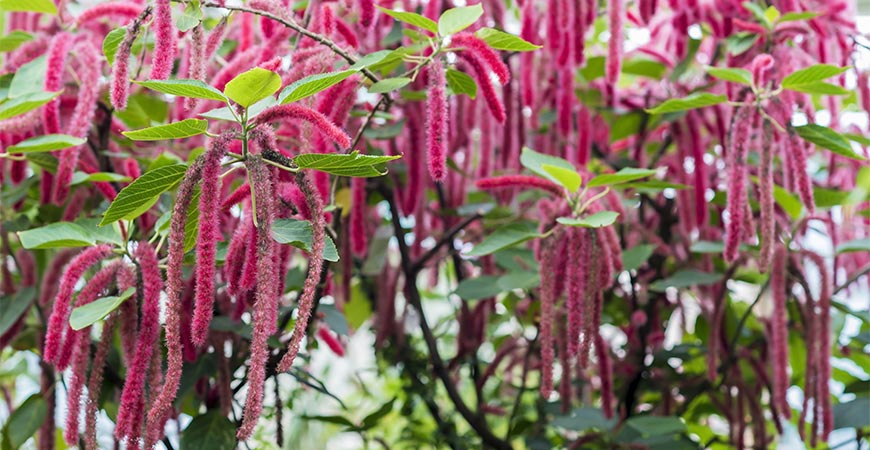
Chenille Plant (Acalypha hispida)
The chenille plant’s red, fuzzy flowers make this indoor plant an eye-catcher. This ornamental plant looks great in a family room, den – any room that needs visual interest and color. Chenille plants grow quickly
. They can grow up to 6 feet in height in the right growing conditions. The red flowers appear as soft, fuzzy balls and grow into long strands of 18 inches or more.
Pruning the chenille plant promotes new, healthy growth with abundant red, caterpillar-like flowers.

Golden Pothos (Epipremnum aureum)
Golden pothos is popular for its attractive, variegated leaves in golden-yellow shades. They are also known for air-purifying, cleaning the air of toxins, which makes for easier breathing.
The plant prefers moderate light, which encourages the best leaf coloration. Apply a balanced liquid fertilizer monthly. Water golden pothos lightly as it has a shallow root system.

English Ivy (Hedera helix)
Reminiscent of English gardens, English ivy is a vining plant known for its glossy, green leaves that gracefully meander down the sides of hanging planters. Give English ivy plenty of room to grow as the vines tend to wind and crawl around the edge of the pot.
A mature one has several heart-shaped leaves available in several colors, from light green to dark green, plus variegated shades.
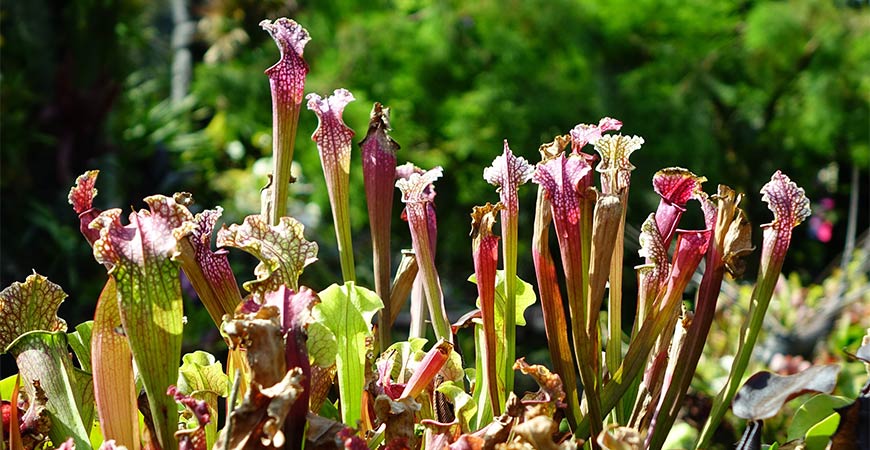
Pitcher Plant (Nepenthes)
Pitcher plants are a type of carnivorous plant and make an exciting addition to your hanging garden.
Place the plant near a window or in a kitchen – any spot where you want to capture small bugs that make their way indoors. Pitcher plants prefer a moist soil mix of 1/2 perlite and 1/2 sphagnum moss.
Water sparingly with distilled water or collected rainwater as it is sensitive to the chemicals present in tap water. If mature, it will thrive with a diet of one to two insects per month that fall into the plant’s tubes, which function as traps for small insects.
If your home is bug-free, add a small, dead bug to one of its fleshy tubes.

Ripple Peperomia (Peperomia Caperata)
Ripple peperomia has unique, heart-shaped leaves in various shades, including red, gray, purple, cream, and green. Some species have textured leaves in various colors and patterns.
Ripple peperomia is easy-care and prefers bright, indirect light from an east or north-facing window. A plant that does not receive sufficient light will grow slowly or not at all. Too much light can fade or burn the plant’s foliage.
Ripple peperomia prefers well-drained soil. Water it when the top one inch of soil feels dry.
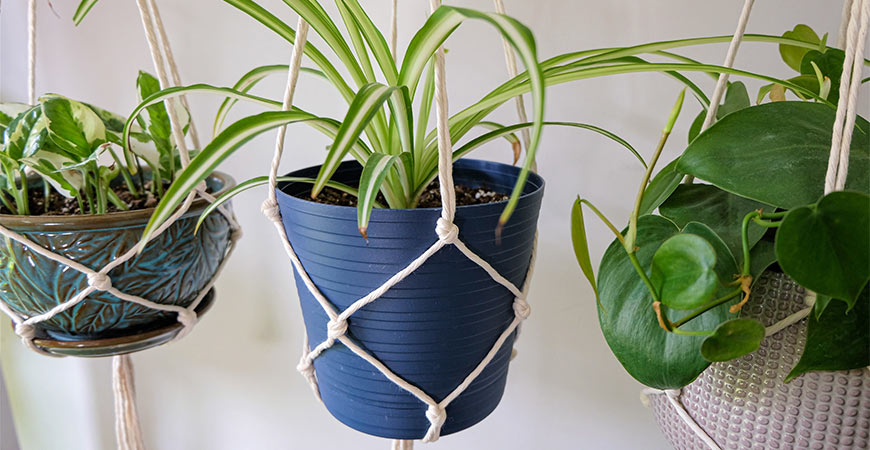
Spider Plant (Chlorophytum comosum)
The spider plant sometimes referred to as an airplane plant, is popular because of its easy-care and attractive, arching leaves and stems that extend from it and gracefully suspend over the edges of hanging planters. Like the golden pothos, it purifies the air, filtering out air pollution, which makes it ideal for bedrooms, nurseries, and home offices.
It also looks best displayed in a wide container to prevent the long, slender leaves from hanging too low. (In the photo above, middle)
For extra tips on taking care of your spider plant, click here.

Trailing Jade (Peperomia rotundifolia)
Trailing jade is a compact indoor hanging plant with small round leaves and thin stems that trail gracefully down the side of a hanging pot. Native to South America rain forests, trailing jade is found trailing through rotten logs and weaving around rock crevices.
Trailing jade thrives in warm indoor locations and filtered light. The leaves are thick and succulent, similar to its peperomia cousins.
Water it when the top layer of soil is dry. Trailing jade works well if you prefer a neat and compact hanging plant for a small space.
How can I make a hanging planter?
Home repair expert Bob Vila says, “Raise not one, not two, but four terra-cotta pots off the floor using this DIY vertical planter from I Heart Naptime. The best part? Scrap wood and rope are all you’ll need to build it—and likely already on hand!”
This DIY orb hanging planter from A Beautiful Mess is crafted from a clear plastic fishbowl and hanging chain. While assembling, tilt the fishbowl slightly to one side for easy plant watering.
Day or night, you’ll enjoy a modern style, see-through view of your greenery.
Macrame hanging planters are a stylish way to hang plants in your home (see spider plant photo above). This easy DIY method to hang planters will give your home a boho feel.
Our how-tos and tips will help you grow the perfect hanging houseplant – no green thumb required!





